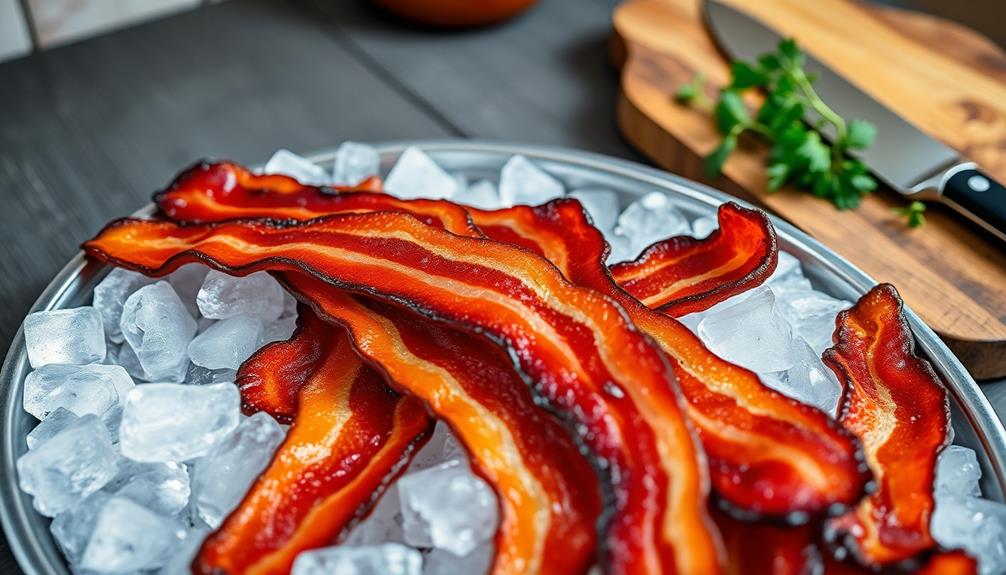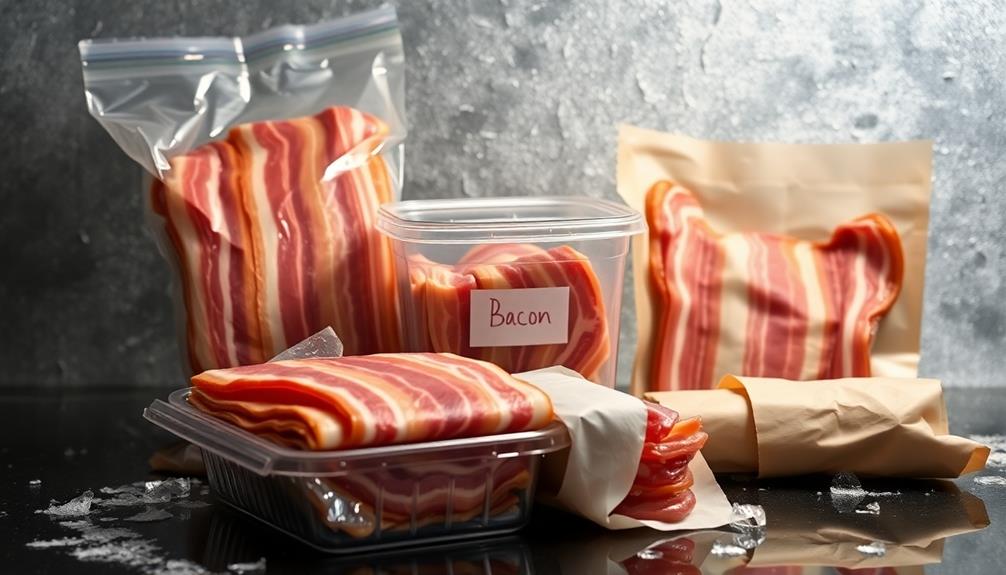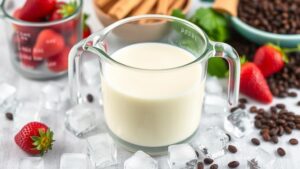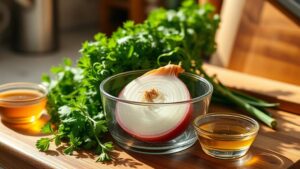To freeze bacon for long-term storage and savings, start with high-quality, uncooked slices. Wrap each slice in wax paper to prevent sticking, then store them in airtight freezer bags. Make sure to remove excess air to avoid freezer burn. You can also layer slices using the accordion method or flash freeze them rolled up on a baking sheet. Label each bag with the date for easy tracking. When you're ready to cook, you can use frozen bacon directly, or thaw it in the refrigerator or cold water. There's more to discover about maximizing your bacon's potential.
Benefits of Freezing Bacon
Freezing bacon offers several benefits that can enhance your cooking experience. When you freeze bacon, you can buy in bulk during sales, helping you save money while stocking up for future meals. This means you can enjoy bacon whenever you want without worrying about it going bad before you use it.
Additionally, utilizing coupon codes for discounts when purchasing bacon can lead to even more savings, making it a budget-friendly option. By freezing individual slices of bacon, you can prevent waste and only thaw what you need for a specific recipe. This flexibility makes meal prep easier and allows you to incorporate bacon into various dishes without committing to an entire package.
Properly frozen bacon can maintain its quality for up to six months, although it's best to use it within three months for peak flavor and texture.
Additionally, freezing bacon helps you manage food storage efficiently, preserving excess bacon that might otherwise go unused before its expiration date. You'll find that having a stash of frozen bacon on hand not only enhances your cooking options but also reduces the likelihood of food waste.
Selecting the Right Bacon
When selecting bacon, you should focus on the type and quality to guarantee a tasty result.
To maximize your savings and investment potential, it's important to reflect on how the quality of your food choices can impact overall financial health, much like the principles of tracking progress in financial management.
Look for double-smoked, thick-cut options that offer great flavor and a satisfying texture.
Pay attention to freshness and the meat-to-fat ratio, as these factors play a big role in how well your bacon will freeze and taste later.
Types of Bacon Available
Selecting the right bacon can elevate your culinary creations, so it's vital to know what to look for. When you're at the meat counter, opt for thick-cut, double-smoked bacon. These options typically provide a richer flavor and better texture than regular varieties. Fresh bacon packs often offer better prices and higher quality than pre-packaged options, so make that your go-to choice.
As you browse, visually assess the meat-to-fat ratio. A good balance is important for achieving the best flavor and cooking results. Avoid bacon with excessive water content, as this can lead to a rubbery texture and less crispy cooking. You'll want to enjoy that satisfying crunch!
Also, check for minimal additives or preservatives. This guarantees a more natural and healthier product, which is especially important if you plan to store bacon in the fridge for longer periods.
Quality Indicators to Consider
Choosing quality bacon can greatly impact your cooking experience. When you're at the meat counter, opt for double-smoked, thick-cut varieties. These options not only enhance the flavor but also provide a satisfying texture.
Fresh bacon often has a better meat-to-fat ratio compared to pre-packaged bacon, which can lead to a more delicious outcome. Look for bacon that strikes a balance between meat and fat. This guarantees you get a rich flavor without excessive greasiness.
It's best to avoid pre-packaged bacon when possible, as it often contains preservatives and additives that can compromise taste and quality. Always inspect the bacon for freshness. Quality indicators include a vibrant color without any discoloration or off-putting odors.
If the bacon looks fresh and smells good, you're likely on the right track. Remember, the quality of the bacon you choose now will affect how well it freezes and how it'll taste when you're ready to cook with it.
Best Bacon for Freezing
Opt for thick-cut and double-smoked bacon when freezing to guarantee maximum flavor and texture after thawing. These varieties stand out for their robust taste, making your meals even more enjoyable.
When selecting your bacon, keep these tips in mind:
- Choose fresh options from the butcher's counter for better quality.
- Look for a balanced meat-to-fat ratio to enhance flavor and avoid greasiness.
- Avoid pre-packaged bacon, as it often contains preservatives.
- Consider how you plan to use the bacon; high-quality options are ideal for recipes requiring smaller portions.
- Don't hesitate to ask the butcher for recommendations on the best cuts available.
Preparing Bacon for Freezing

To get the best results when freezing bacon, start by selecting high-quality, uncooked strips.
Proper wrapping techniques are essential, so lay the slices on wax paper and fold it over each one for easy access later.
This method not only prevents sticking but also maintains freshness for months, similar to how freelancers can keep track of expenses with tools like expense tracking features in budgeting apps.
This way, you'll prevent sticking and keep your bacon fresh for months.
Selecting Quality Bacon
When it comes to selecting quality bacon for freezing, you'll want to look for double-smoked, thick-cut varieties that promise better flavor and texture. These selections guarantee that your bacon retains its deliciousness even after freezing.
Here are some tips to help you make the best choice:
- Check for a good meat-to-fat ratio; this balance enhances both taste and cooking quality.
- Seek out fresh bacon at the meat counter, where prices and quality often surpass pre-packaged options.
- Avoid pre-packaged bacon whenever possible, as these often contain preservatives that can compromise the flavor and quality during freezing.
- Choose bacon with minimal additives and artificial ingredients to maintain the best taste after thawing and cooking.
- Look for clear packaging that allows you to see the bacon's quality before purchasing.
Proper Wrapping Techniques
Wrapping bacon properly for freezing is crucial to maintaining its quality and flavor. Start by using wax paper to individually wrap each slice of bacon. Lay the first slice on a long piece of wax paper and fold the paper over it. Continue stacking additional slices, creating an accordion-like arrangement. This method prevents sticking and makes it easier to grab what you need when you're ready to cook.
Once you've wrapped the slices, place them in a gallon-sized freezer bag. Be sure to remove as much air as possible from the bag to prevent freezer burn. It's a good idea to label the freezer bag with the date and type of bacon, so you can keep track of freshness and guarantee optimal usage within six months.
For added protection against air exposure, consider wrapping the entire freezer bag in another layer of wax paper. This extra step helps keep your frozen bacon tasting great for longer.
Methods for Freezing Bacon
Freezing bacon properly is essential for maintaining its quality and guaranteeing easy access when you need it. Here are some effective methods you can use to freeze your bacon:
- Individual slices: Wrap each slice in wax paper for easy access later.
- Accordion method: Layer bacon slices between sheets of wax paper for quick thawing.
- Coiled bacon: Roll bacon into coils and freeze on a baking sheet to prevent sticking.
- Flash freezing: Place raw bacon on a cooling rack or lined baking sheet to freeze slices individually without clumping. This method is similar to how expense management apps offer enhanced accuracy and organization by minimizing the risk of clumped receipts or expenses.
- Cook from frozen: Thawed bacon can be cooked directly from the freezer, saving time in meal prep.
Using these methods, you can efficiently store bacon in your freezer without sacrificing quality.
Individual slices wrapped in wax paper guarantee that you can grab just what you need without thawing the entire package. The accordion method simplifies access, while coiling bacon allows you to control portion sizes.
Flash freezing helps maintain the integrity of each slice, making your frozen bacon storage a breeze. With these techniques, you'll always have delicious bacon ready for your meals!
Storing Frozen Bacon

Maintaining the freshness of frozen bacon hinges on proper storage techniques. To start, use airtight freezer bags or vacuum-sealed containers to store frozen bacon. This prevents freezer burn and keeps your bacon fresh for up to six months.
Make certain to label each package with the date of freezing; this helps you track freshness and use the oldest packages first, following the FIFO method. Additionally, implementing a good budgeting strategy can help you save money on groceries, making it easier to stock up on items like bacon for longer periods. For beginners, using a budget app like YNAB (You Need a Budget) empowers users to take control of their financial health and goals.
If you prefer individual servings, wrap each slice in wax paper before placing them in a freezer bag. This way, you can easily grab slices as you need without thawing the whole package.
For best preservation, regularly check your freezer temperature; it should be set at 0°F (-18°C) or lower.
An excellent method to prepare your bacon for storage is to lay the slices on a baking sheet with parchment. Freeze them flat before transferring to freezer bags. Avoid overpacking the bags to guarantee the slices freeze flat, making for easier storage and quicker thawing when you're ready to use them.
With these methods, you can enjoy delicious bacon whenever you want!
Thawing Frozen Bacon
When it's time to enjoy your frozen bacon, thawing it properly is key to preserving its taste and texture. Using methods that maintain quality can also save you money in the long run, especially if you leverage significant savings on groceries through e-coupons.
Here are some safe thawing methods to take into account:
- Place it in the refrigerator overnight for gentle thawing.
- Submerge the sealed package in cold water for a quick thaw.
- Avoid using the microwave, which can lead to uneven cooking.
- Cook bacon directly from frozen if you're in a hurry.
- Always cook thawed bacon immediately and avoid refreezing.
The safest method for thawing frozen bacon is to place it in the refrigerator overnight. This gradual process keeps the bacon at a safe temperature below 40°F (4°C).
If you need it sooner, the cold water method works well—just change the water halfway through to keep it cold.
While it's tempting to use the microwave, this can partially cook the bacon, affecting its texture and flavor.
If you're short on time, you can always cook bacon directly from frozen, adding a few extra minutes to your cooking time.
Using Frozen Bacon

Using frozen bacon is a game-changer for quick meals, as you can cook it straight from the freezer, saving you time and effort in meal preparation.
Additionally, the convenience of having frozen bacon on hand allows for personalized shopping experiences that cater to your cooking preferences.
You can whip up delicious dishes like pasta or soups while enjoying the added flavor and protein.
Just keep an eye on cooking times, as they can vary between frozen and thawed bacon.
Cooking Frozen Bacon Tips
Cooking frozen bacon can be a convenient and tasty solution for quick meals. If you've got a busy week ahead or just want to save time, here are some tips to keep in mind:
- Cook straight from frozen for a quicker meal.
- Use a baking sheet to avoid mess and guarantee even cooking.
- Increase cooking time slightly for that perfect crispiness.
- Monitor doneness closely; frozen bacon cooks faster than thawed.
- Incorporate it into dishes like salads or pasta without defrosting the whole package.
When bacon has frozen, you can easily cook bacon directly from the freezer. Just make certain to adjust your cooking method—whether you prefer a skillet or the oven, both work well.
If you choose the oven, place the frozen bacon on a baking sheet and let it bake until it reaches your desired crispness.
Remember, cooking thawed bacon immediately after removing it from the freezer typically yields the best texture and flavor.
Recipe Ideas With Bacon
Bacon brings a savory punch to any dish, and frozen bacon makes it easier than ever to add that flavor without the hassle of thawing. You can toss frozen bacon straight into a quiche, where it'll cook beautifully and enhance the overall taste.
Want to make a hearty soup? Use thawed bacon in potato or clam chowder to enrich the broth; just add it toward the end for maximum flavor.
For an easy appetizer, wrap thawed bacon around veggies or cheese and bake until crispy—it's a fantastic finger food option.
If you're in the mood for a salad, chop frozen bacon directly into a Cobb salad; it adds a crunchy, flavorful element without any thawing time.
And don't forget pasta! Thawed bacon works wonders in dishes like carbonara or spaghetti. Render it crispy and mix it with eggs and cheese for a rich, creamy sauce.
With these recipe ideas, you'll find that both frozen and thawed bacon can elevate your meals effortlessly. So go ahead, stock up on bacon and get creative in the kitchen!
Nutritional Considerations
Understanding the nutritional profile of bacon is essential for making informed dietary choices. When you consider adding bacon to your meals, keep these key points in mind: ethical shopping practices can also influence the quality of the bacon you purchase, as supporting sustainable businesses can lead to healthier and more responsibly sourced products support sustainable businesses.
- Bacon provides approximately 37 grams of protein per 100 grams.
- It contains around 42 grams of fat, with roughly 39% being saturated fat.
- A typical serving of cooked bacon (about 2 slices) has around 80 calories.
- Bacon is a source of essential vitamins, particularly B1, B2, B3, B6, and B12.
- It also contains important minerals like phosphorus and selenium.
While bacon can enhance the flavor of your dishes, it's vital to consume it mindfully. The high levels of saturated fat and calories mean that moderation is key.
Excessive consumption could lead to health concerns, such as increased cholesterol levels and a higher risk of heart disease. By balancing your bacon intake with other nutritious foods, you can enjoy its rich taste while maintaining a healthy diet.
Always check the nutritional information on the packaging to make the best choices for your health.
Alternative Bacon Storage

When you're looking for ways to store bacon long-term, several alternative methods can help you keep it fresh and flavorful. One option is canned bacon, which offers a shelf-stable solution perfect for emergency preparedness or camping trips. It can last up to 10 years when unopened, making it an excellent long-term storage choice.
Another alternative is freeze-dried bacon. This method retains the flavor and nutritional value of bacon, lasting 25 years or more if stored properly in airtight containers.
If you're looking for convenience, commercially available pre-cooked bacon can be a great option. Once opened, it lasts up to 4 weeks in the fridge or can be frozen for extended use.
For those who prefer a non-meat option, consider bacon-flavored TVP (textured vegetable protein). It offers a longer shelf life and can easily substitute traditional bacon in various recipes.
While home pressure canning of bacon is controversial and requires thorough research due to safety concerns, these alternatives can provide you with flexible options for bacon storage without compromising on taste or quality.
Tips for Maintaining Quality
Properly storing bacon is just the beginning; maintaining its quality during long-term storage is equally important. Follow these tips to keep your bacon fresh and delicious:
- Wrap individual bacon slices in wax paper to prevent freezer burn.
- Use freezer bags to store the wrapped slices, guaranteeing an airtight seal.
- Flash freeze bacon slices on a baking sheet before transferring them to bags to avoid sticking.
- Maintain your freezer at a consistent 0°F (-18°C) for ideal freshness and a shelf life of up to six months.
- Label all freezer bags with the date of freezing to track freshness and guarantee you use them within the recommended timeframe.
Implementing these practices will help you maintain quality and enjoy your bacon as if it were freshly bought.
The key is to take a little extra time upfront for long-term benefits. By wrapping and storing your bacon correctly, you guarantee that every slice remains flavorful and ready to cook whenever you need it.
With these simple steps, you can savor your bacon while saving money and minimizing waste. Happy cooking!
Conclusion
Freezing bacon isn't just a smart way to save money; it's like having a little stash of breakfast joy waiting for you. Imagine pulling out perfectly preserved strips on a chilly morning, the sizzle filling your kitchen as the aroma wafts through the air. With just a few simple steps, you've turned bacon into a long-lasting treat. So go ahead, store it well, and enjoy that delicious, crispy goodness whenever the craving strikes!



